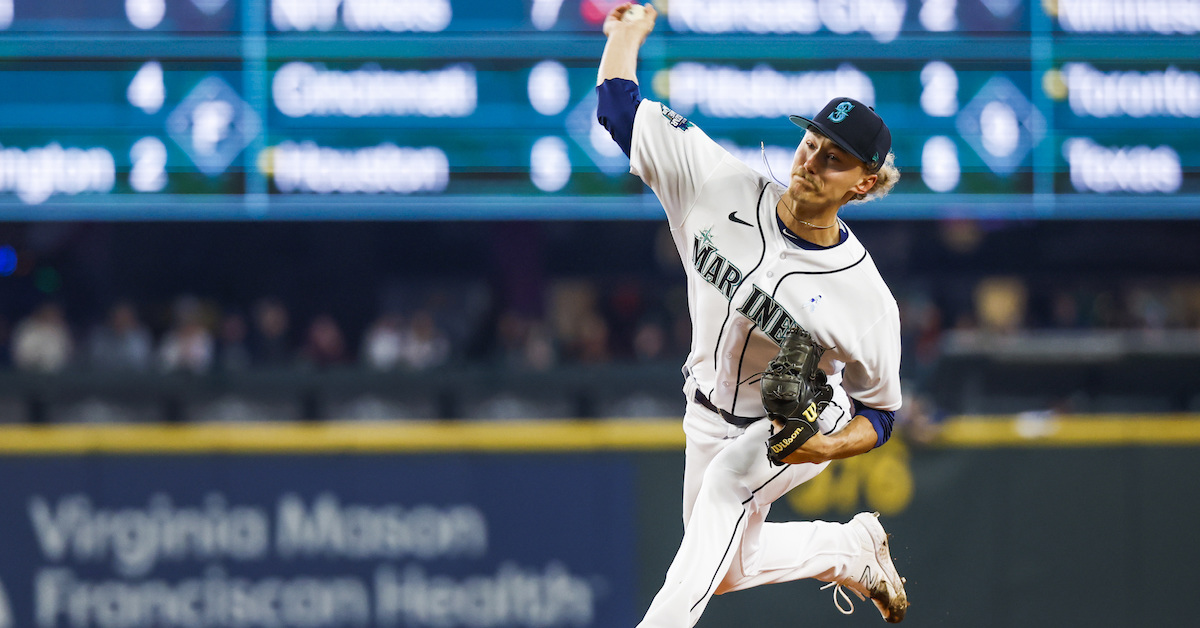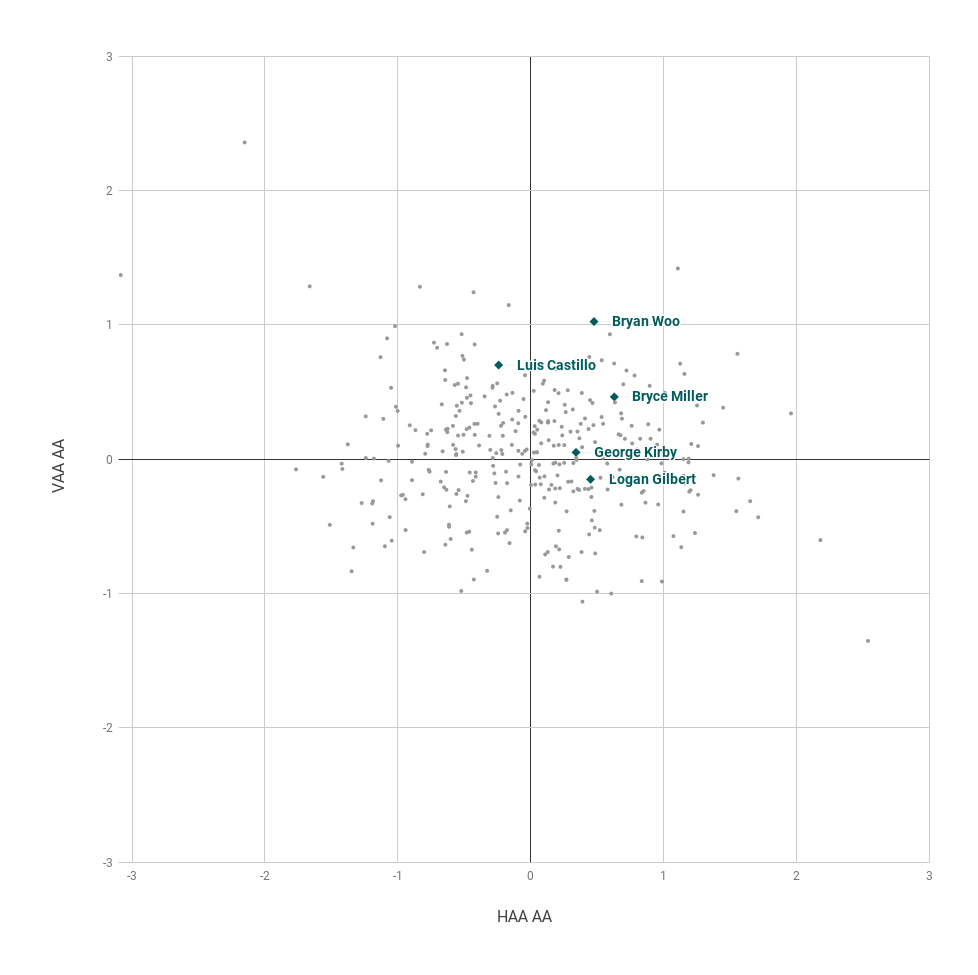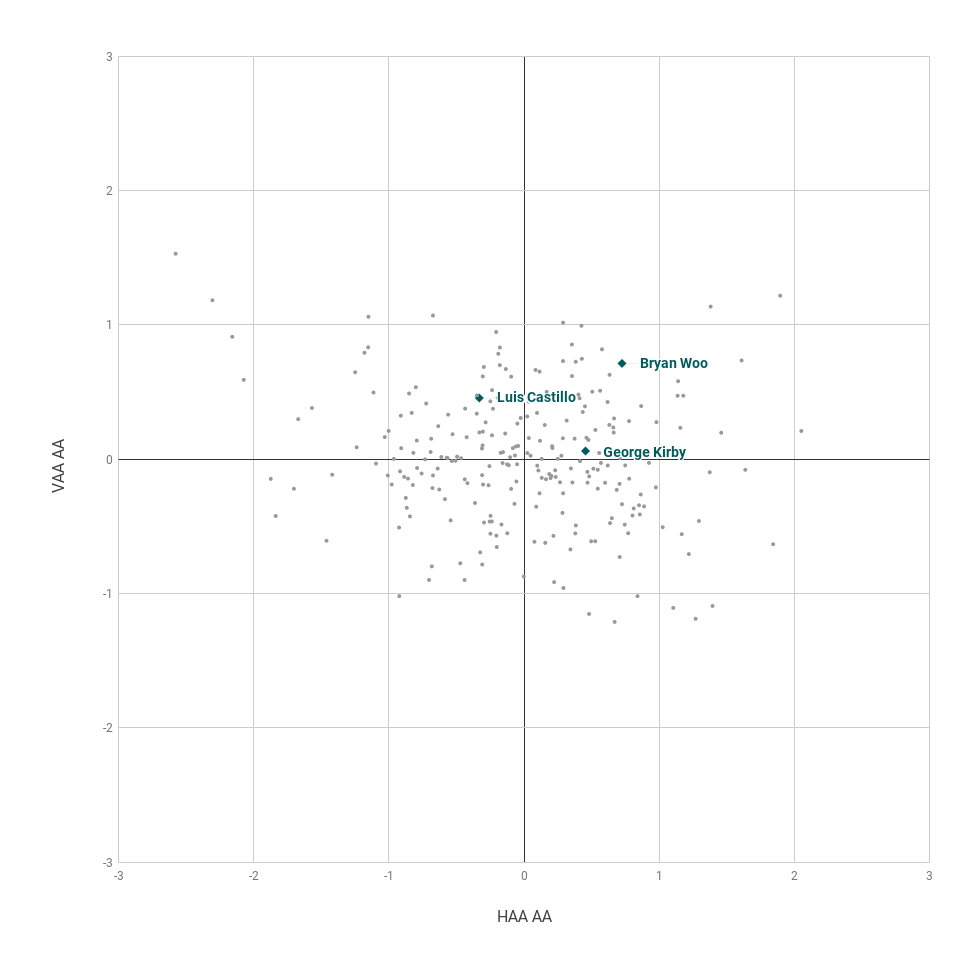The Mariners Graduated Another Pair of Impact Starters

In 2021, the Mariners called up Logan Gilbert, their no. 3 prospect at the time; he has compiled a tidy 7.0 WAR across nearly 400 innings over the last three years. Last year, the Mariners called up George Kirby, their no. 3 prospect at the time; he was a key member of the rotation that helped break Seattle’s two-decade-long postseason drought. With Luis Castillo joining the rotation at the trade deadline last season and then signing a five-year extension in September, Robbie Ray heading into the second year of his five-year deal he signed prior to the 2022 season, and Marco Gonzales eating innings at the back of the rotation, Seattle entered this season with a starting five that appeared to be the biggest strength on the roster.
Things haven’t gone exactly according to plan. Ray injured his elbow in his first start of the season and underwent season-ending Tommy John surgery in early May; Gonzales has been out since late May with his own elbow issues. But despite losing two members of the Opening Day rotation, the Mariners have barely skipped a beat, thanks to the efforts of two more top prospects who have graduated to the majors this year: Bryce Miller and Bryan Woo. Seattle’s starters have the fourth best park- and league-adjusted FIP in the majors, and a park- and league-adjusted strikeout-to-walk ratio that ranks inside the top 20 among all 300 team seasons over the last decade. Only the Twins are outpacing them in those two categories in the American League.
After trying to fill Ray’s spot with a combination of Chris Flexen, Tommy Milone, and Easton McGee, the Mariners called up Miller on May 2 to make his debut against the light-hitting Athletics. He dazzled across six innings, allowing just two baserunners and one run and striking out ten. Across his first five starts in the majors, he allowed just 17 baserunners total, giving him the lowest WHIP (0.51) through a pitcher’s first five career starts in MLB history. A rough pair of outings against the Yankees and Rangers have been the lone blemish on Miller’s ledger; he’s bounced back with three excellent starts since then. Overall, he’s compiled a 3.88 ERA and a 3.36 FIP with a fantastic 4.45 strikeout-to-walk ratio.
As soon as Gonzales hit the IL with his injury, the Mariners quickly turned to another one of their youngsters. Woo made his debut on June 3, though his introduction to the big leagues did not go as well as Miller’s; given the assignment of slowing down the Rangers’ high-powered offense, he lasted just two innings, allowing six runs on seven hits and striking out four. He’s been much better over his last four starts, allowing just six runs total and posting a 5.60 strikeout-to-walk ratio. If you lower the bar far enough, Woo has the fourth-highest strikeout rate among all starters with at least 20 innings pitched this year.
The Mariners have a reputation for being an advanced ballclub as far as pitch development, strategy and design go. Last year, I wrote about how they had found a couple of relievers with similar characteristics to Paul Sewald, one of their biggest development successes. Michael Ajeto picked up that same thread in a more recent piece for Baseball Prospectus examining Seattle’s latest batch of breakout relievers. The benefits of that pitching strategy group extends to the starting rotation as well. I’m sure they had plenty of input into selecting Miller and Woo in the 2021 draft — in the fourth and sixth rounds, respectively — and guiding them through their quick ascent through the organization to their debuts this year.
Miller’s calling card is a fastball with tons of carry, sitting in the 93rd percentile for induced vertical break among all four-seam fastballs thrown at least 50 times this year. In an interview with David Laurila, Mariners manager Scott Servais compared it to Gerrit Cole’s fastball after he unlocked it in Houston. Miller throws it two-thirds of the time, and even though opposing batters know it’s coming, they’ve been unable to do much against it. His whiff rate with the pitch is 23%, just a hair above average for a four-seamer, but because it has so much ride to it, batters have a very difficult time getting the barrel on it when they do make contact. He’s allowing a .273 wOBA off the pitch and the expected wOBA on contact is just .359, well below average for the pitch type.
Woo’s fastball stands out even more. Like many of the relievers the Mariners have accumulated, he throws from a pretty low arm slot, which allows him to throw an extremely flat fastball. That’s helped him post a 30.1% whiff rate, a .301 wOBA and a .333 expected wOBA on contact with his heater. Between his four-seamer and his sinker, more than three-quarters of Woo’s pitch mix is a fastball.
Things get a little more interesting when you compare the four-seam fastballs from each of the five members of the Mariners rotation:
| Player | Velocity | Spin Rate (Active) | Spin Axis | V Mov | V Release | V Location | VAA AA | Stuff+ |
|---|---|---|---|---|---|---|---|---|
| Bryce Miller | 95.0 | 2608 (86%) | 12:30 | 18.8 | 5.8 | 2.74 | +0.46 | 124 |
| Luis Castillo | 96.2 | 2333 (87%) | 1:45 | 14.1 | 5.2 | 2.90 | +0.70 | 100 |
| Bryan Woo | 95.3 | 2225 (86%) | 1:30 | 15.3 | 4.9 | 2.86 | +1.02 | 99 |
| George Kirby | 95.8 | 2224 (87%) | 1:15 | 15.3 | 5.9 | 3.06 | +0.05 | 95 |
| Logan Gilbert | 95.2 | 1987 (98%) | 12:45 | 17.6 | 6.2 | 2.97 | -0.15 | 88 |
Miller’s fastball sits well above any of the others in Stuff+, likely due to the extreme amount of ride on the pitch. That vertical movement imparted by an extremely high spin rate gives the pitch an above-average vertical approach angle. Woo’s fastball compares favorably with Castillo’s: They both throw from low slots and get a decent amount of ride on their fastballs, but the majority of their flatness is imparted through their arm slot.
Here’s another way to visualize their fastballs:

Inspired by some research done by Robert Orr of Baseball Prospectus, the chart above compares the vertical approach angle and horizontal approach angle of every four-seam fastball thrown at least 50 times this year; the Mariners’ starters are highlighted. Castillo and Miller stand out from the norm, but Woo’s heater is out on an island. That kind of unique pitch shape gives him a huge advantage: batters are either swinging and missing or they’re mis-hitting the pitch when they do make contact. It doesn’t fit into the ledger of the thousands of four-seam fastballs they’ve seen throughout their careers, and they’re struggling to do anything productive against it.
Woo’s uniqueness doesn’t end with his four-seamer; he also throws a sinker that also has an extremely uncommon shape to it.
| Player | Velocity | Spin Rate (Active) | Spin Deviation | V Mov | VAA AA | H Mov | HAA AA | Stuff+ |
|---|---|---|---|---|---|---|---|---|
| Bryan Woo | 95.2 | 2069 (87%) | -60 | 6.3 | +0.71 | -17.3 | +0.73 | 114 |
| George Kirby | 95.5 | 2112 (90%) | -45 | 5.3 | +0.05 | -18.8 | +0.45 | 104 |
| Luis Castillo | 95.7 | 2229 (84%) | -60 | 10.4 | +0.46 | -15.7 | -0.33 | 84 |
Again, Woo’s sinker compares favorably with Castillo’s, but he gets above-average sink and run on his. Even though its raw vertical movement isn’t as high as Castillo’s, Woo’s sinker has a better vertical approach angle because of his lower arm slot. And that same arm slot provides a sharper horizontal approach angle as well. His sinker has been hit around a little more than his four-seamer, but he’s also generating a 20.8% whiff rate with the pitch, well above average for the pitch type.
Here’s the same approach angle visualization for sinkers, with Mariners starters highlighted:

There’s Woo, once again out on an island with a unique pitch shape.
Miller’s development path needs to be focused on his breaking balls. He throws three different variations on a slider: a hard cutter-ish version at 86 mph, a sweeper at 81 mph, and a slurvy breaker at 78 mph that’s classified as a curveball. None of them have produced great results so far, though opposing batters have struggled to put his hard slider in play with any authority. None of the three breaking balls possess whiff rates anywhere close to average for their individual pitch types, which is a big reason why Miller’s strikeout rate lags behind Woo’s.
Woo does have a decent sweeper slider that’s generated a whiff a third of the time opposing batters offer at it. His breaking ball has 12 inches of horizontal movement on average, and it’s been especially useful against right-handed batters. His development path should be focused on honing his changeup to give him a solid fourth pitch and something to use against left-handed batters to keep them off his fastballs.
The trend in pitching these days is to move away from your fastball in favor of a big breaking ball; hard stuff is easier to hit, and bendy stuff usually generates more swings and misses. With Miller and Woo, the Mariners are proving that a great fastball can still be the backbone of a starter’s repertoire, especially when their secondary offerings are still raw. They’re going about it in two different ways, but these two youngsters possess outstanding characteristics on their fastballs, and that’s led to plenty of early success in their careers.
Jake Mailhot is a contributor to FanGraphs. A long-suffering Mariners fan, he also writes about them for Lookout Landing. Follow him on BlueSky @jakemailhot.

Is Emerson Hancock next? Went all in ina rookie draft for SEA SP with Gilbert, Kirby, and Hancock over the last two years but missed on Miller and Woo. Hoping Hancock makes the jump if theres any injury.
Hancock was supposed to be the closest of the 1st round pitchers coming out of the draft, but he’s been leapfrogged by Miller, Woo, and Dollard. It seems like there isn’t a whole lot of belief that he will be a productive big league starter at this point.
Hancock needs to work on cobsistency, but I still think he’ll end up a }4 or better starter sonewhere